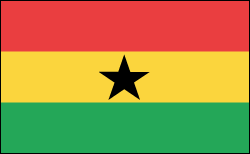Republic of Ghana

*three equal horizontal bands of red (top), yellow, and green, with a large black five-pointed star centered in the yellow band; red symbolizes the blood shed for independence, yellow represents the country's mineral wealth, while green stands for its forests and natural wealth; the black star is said to be the lodestar of African freedom
| Country Name: | |
Conventional long form: Republic of Ghana
Conventional short form:
Ghana
Former:
Gold Coast
| |
President: John Dramani Mahama (2012)
Population (2012 est.): 25,241,998
Life Expectancy: 61.45 years
Life Expectancy: 61.45 years
Land area: 88,811 sq mi (230,020 sq km);
total area: 92,456 sq mi (239,460 sq km)
*About the size of the state of Oregon.
Capital: Accra, 2.269 million (2009)
Other Large Cities:
Kumasi, 1.773 million (2009)
Monetary Unit: Cedi ( 1 Cedi = 0.528 U.S. Dollar)
| ||||
definition: age 15 and over can read and write
total population:
67.3%
male:
73.2%
female:
61.2% (2010 census)
Education:
Primary School: 6 years (*Kindergarten: 2 years); Junior Secondary School: 3 years; Senior Secondary School: 4 years
| ||||
Monetary Unit: Cedi ( 1 Cedi = 0.528 U.S. Dollar)
| Languages: | |
Asante 14.8%, Ewe 12.7%,
Fante 9.9%, Boron (Brong) 4.6%, Dagomba 4.3%, Dangme 4.3%, Dagarte
(Dagaba) 3.7%, Akyem 3.4%, Ga 3.4%, Akuapem 2.9%, other (includes
English (official)) 36.1% (2000 census)
Religions:
Christian 68.8% (Pentecostal/Charismatic 24.1%, Protestant 18.6%,
Catholic 15.1%, other 11%), Muslim 15.9%, traditional 8.5%, other 0.7%,
none 6.1% (2000 census)
| |
Government Type: |
|||||
Constitutional democracy
National Symbol(s):
| |||||
Recent News:
President Atta died in July 2012. His four years in office were marked
by stability and an increase in oil production. Vice President John
Dramani Mahama was sworn in shortly after Atta's death.
| |
No comments:
Post a Comment